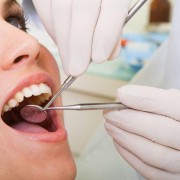Should I get my teeth whitened?
Almost everyone desires a bright, white, attention-grabbing smile. Since a beaming smile is such a coveted asset, teeth whitening is the most common cosmetic procedure that dentists perform.
Professional teeth whitening is also popular because it’s a non-invasive treatment that doesn’t permanently alter dental structures like other cosmetic procedures such as porcelain veneers or tooth-colored crowns.
Before we can get into the details of how teeth whitening works, it’s important to understand how unsightly stains develop.
How Dental Stains Form
Your teeth are made up of an inner layer called dentin and an outer layer enamel. Enamel is hard and shiny but is easily stained. Food, and other substances build up on your teeth in the form of a tiny particle layer called a “pellicle film.”
Brushing your teeth can control the development of pellicle film. Beyond good oral hygiene, a dentist can clean away this film through teeth cleanings.
The pellicle layer gradually gives way to discoloration in the enamel layer, discoloring it slightly. Over time, these stains appear more noticeable, and that’s why many adults eventually seek out teeth whitening treatments.
Stains can also form in the dentin layer of teeth—particularly when tooth enamel is compromised by decay, wear and tear, and dental injuries.
Common causes for stains
- Foods/Drinks: Coffee, tea, soda, wines and dark-colored foods like beets and berries.
- Tobacco use including smokeless varieties.
- Poor oral hygiene.
- Medicine including antihistamines, antidepressants and high blood pressure pills.
- Age: As you get older, the outer layer of enamel on your teeth wears away, revealing dentin’s natural, yellow color.
- Genetics—certain folks have thinner tooth enamel, which leaves the innermost structures of teeth vulnerable to stain-causing agents.
- Exposure to too much fluoride.
Not All Teeth Whitening is Created Equal
Over the counter teeth whiteners typically cannot yield the same results as a professional treatment.
Adding insult to injury, many of these products can be harmful to your teeth. Since over the counter whiteners have weaker formulas, some products rely on harsh abrasives to remove surface stains. A whitening toothpaste, for example, could permanently damage your tooth enamel and cause long-term tooth sensitivity.
When it comes to lightening your teeth, your best bet is to work with your dentist. A dentist has access to prescription-grade products and can help ensure that you improve the appearance of your smile in the safest conditions possible.
How Professional Teeth Whitening Works
In-office treatments will use more powerful formulations and a special high-intensity light that deepens the teeth-whitening process.
Before a tooth whitening treatment at our office, Dr. Chauvin will clean the teeth, fill cavities, and make sure your gums are healthy. Then he will place a hydrogen peroxide paste on the teeth for several minutes, rinse it off, and may apply it several more times. The procedure can lighten teeth up to eight shades after one 40-minute treatment.
Patients’ eyes and their soft oral tissues will be protected during the process with goggles, dental dam, and gauze.
In-home treatments are another popular option. Whitening at home will still utilize clinically-tested, prescription-grade lightening solutions. Our dentist will take a mold of your mouth and make custom mouth trays. Patients will put a thin layer of whitening gel into the tray and wear it for about 2 hours a day for a couple of weeks.
In-home treatments are great for maintaining the results of office-based whitening, too.
Are you looking for professional teeth whitening in Lafayette, La?
Give our family dental practice a call at (337) 234-2186 to reserve a smile makeover consultation with Dr. Chauvin.








